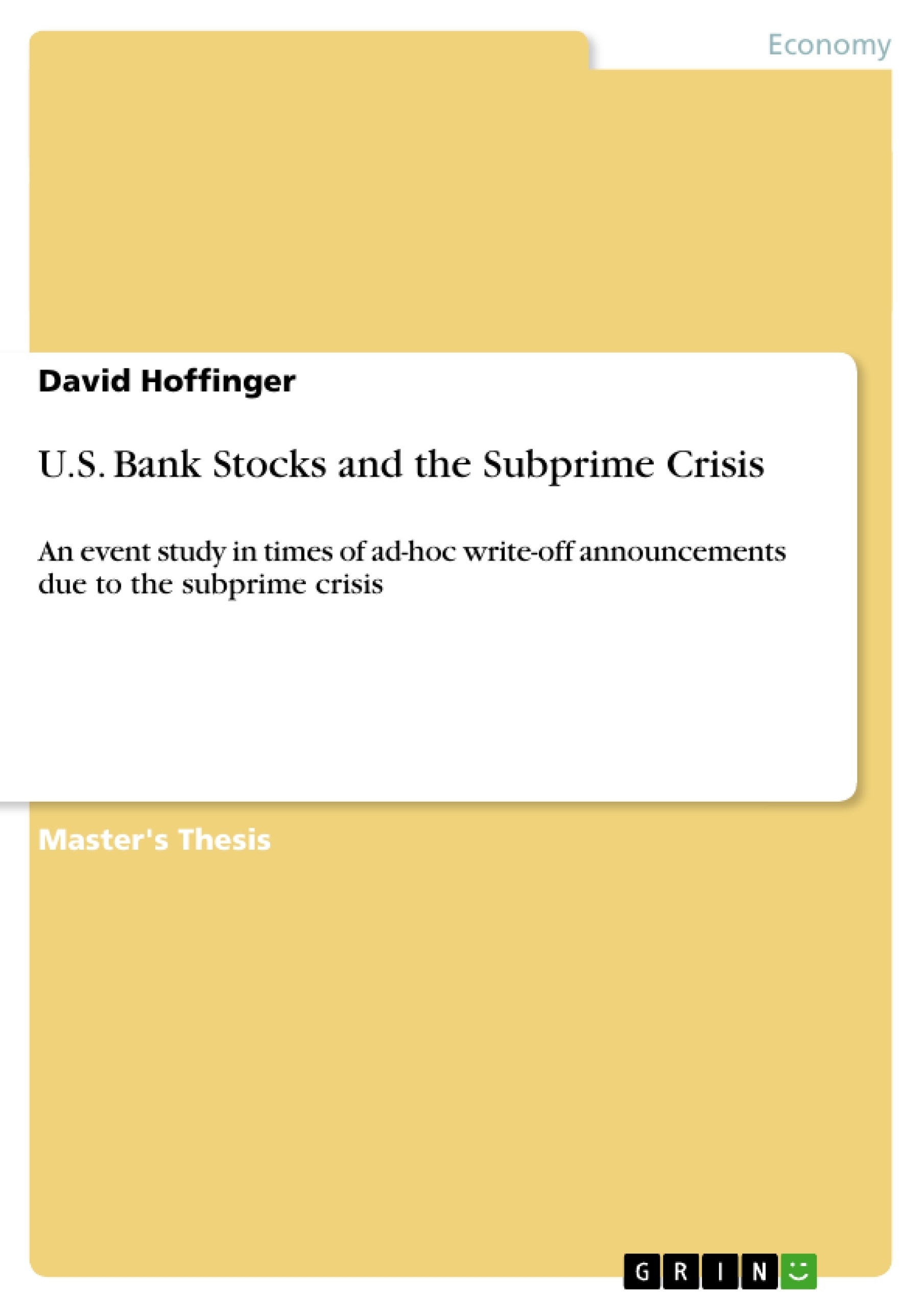This paper examines if U.S. American banks that announced write-offs in their
quarterly reports, due to the so-called subprime crisis, show abnormal returns in
relation to the S&P 500 index in 4 different time periods. The basics and the history
of event studies are mentioned and different methods to determine abnormal returns
and how to test the significance of abnormal returns are explained. The event study
of this paper is evaluated with the market adjusted returns model and Ordinary Least
Squares market model. The estimated abnormal returns are then tested on
significance with parametric and non-parametric tests. Besides that, this paper also
gives a summary about the subprime crisis, the role of players, the sources, the
complexity and the broadening of the crisis.
Inhaltsverzeichnis (Table of Contents)
- 1. Introduction
- 2. The Subprime Crisis
- 2.1. The Risk Types Involved
- 2.2. The Role of the Players
- 2.2.1. Rating Agencies
- 2.2.2. Mortgage Brokers and Lenders
- 2.2.3. Special Investment Vehicles
- 2.2.4. Central Banks
- 2.2.5. Financial Institutions
- 2.3. Impact on Earnings and Stock Prices
- 2.4. The Bailouts
- 2.4.1. Bear Stearns
- 2.4.2. Fannie Mae and Freddie Mac
- 2.4.3. Lehman Brothers Holdings Inc.
- 2.4.4. American International Group
- 2.4.5. Washington Mutual
- 2.5. The Broadening of the Crisis
- 3. The Design of an Event Study
- 3.1. Basics
- 3.2. History of Event Studies
- 3.3. Experimental Design
- 3.4. Use of Daily Data
- 3.4.1. Returns
- 3.4.2. Non-normality
- 3.4.3. Simple Linear Regression
- 3.4.4. Variance Estimation
- 3.4.5. Non-synchronous Trading
- 3.4.6. Clustering
- 3.5. Abnormal Returns
- 3.5.1. Mean Adjusted Return Model
- 3.5.2. Market Adjusted Return Model
- 3.5.3. Capital Asset Pricing Model
- 3.5.4. OLS Market Model
- 3.5.5. Scholes Williams Procedure
- 3.5.6. Dimson Aggregated Coefficients Method
- 3.5.7. Cumulative Abnormal Returns
- 3.6. Significance of Abnormal Returns
- 3.6.1. Parametric Tests
- 3.6.1.1. Cross-sectional Independence
- 3.6.1.2. Cross-sectional Dependence (Crude Adjustment)
- 3.6.1.3. Standardized Tests
- 3.6.2. Non-parametric Tests
- 3.6.2.1. The Rank Test
- 3.6.2.2. The Sign Test
- 3.6.1. Parametric Tests
- 4. Results of the Event Study
- 4.1. Estimated Abnormal Returns
- 4.1.1. Release of the Third Quarter 2007 Earnings
- 4.1.2. Release of the Fourth Quarter 2007 Earnings
- 4.1.3. Release of the First Quarter 2008 Earnings
- 4.1.4. Release of the Second Quarter 2008 Earnings
- 4.2. Diagnostics
- 4.2.1. Test for Normality of Arithmetic Returns
- 4.2.2. Test for Normality of Abnormal Returns
- 4.2.3. Autocorrelation of the Stocks
- 4.3. Results of Significance Tests of Abnormal Returns
- 4.3.1. Significance, Event of Third Quarter 2007 Earnings Releases
- 4.3.2. Significance, Event of Fourth Quarter 2007 Earnings Releases
- 4.3.3. Significance, Event of First Quarter 2008 Earnings Releases
- 4.3.4. Significance, Event of Second Quarter 2008 Earnings Releases
- 4.1. Estimated Abnormal Returns
- 5. Summary
Zielsetzung und Themenschwerpunkte (Objectives and Key Themes)
This master's thesis aims to investigate whether U.S. banks announcing write-offs due to the subprime crisis experienced abnormal stock returns compared to the S&P 500 index. The study employs event study methodology, explaining its basics and various methods for assessing abnormal returns and their significance.
- Impact of subprime crisis write-off announcements on U.S. bank stock returns.
- Application and comparison of different event study methodologies.
- Analysis of the significance of abnormal returns using parametric and non-parametric tests.
- Overview of the subprime crisis, its key players, and its cascading effects.
- Examination of the relationship between write-off announcements and market reactions.
Zusammenfassung der Kapitel (Chapter Summaries)
Chapter 1 introduces the research question and outlines the methodology. Chapter 2 provides background on the subprime crisis, detailing its causes, key players, and consequences. Chapter 3 describes the event study methodology, covering various models and statistical tests. Chapter 4 presents the empirical results of the event study, focusing on the estimated abnormal returns and their significance for different periods.
Schlüsselwörter (Keywords)
Subprime crisis, event study, U.S. bank stocks, abnormal returns, write-offs, market efficiency, parametric tests, non-parametric tests, financial crisis, market adjusted returns, OLS market model.
- Citation du texte
- Bachelor David Hoffinger (Auteur), 2009, U.S. Bank Stocks and the Subprime Crisis, Munich, GRIN Verlag, https://www.grin.com/document/123178



